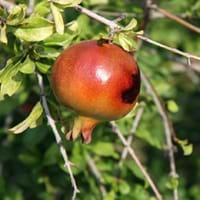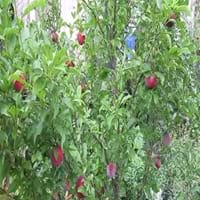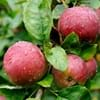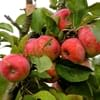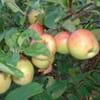Life Span
Perennial
Perennial
Origin
India, Mediterranean
Hybrid origin
Types
Not available
Not Available
Habitat
Subtropical climates, Tropical regions
Forest margins, Scrubs, sluggish streams and rivers
USDA Hardiness Zone
4-8
6-10
AHS Heat Zone
Not Available
9-1
Sunset Zone
Not Available
H1, 2a, 2b, 3a, 3b, 4, 5, 6, 7, 8, 9, 12, 13, 14, 15, 16, 17, 18, 19, 20, 21, 22, 23, 24
Habit
Oval or Rounded
Oval or Rounded
Flower Color
Deep Red, Red
White
Flower Color Modifier
Bicolor
Bicolor
Fruit Color
Red
Red, Purple
Leaf Color in Spring
Green
Green
Leaf Color in Summer
Green
Green
Leaf Color in Fall
Green, Light Yellow, Brown
Green
Leaf Color in Winter
Light Green
Light Green
Leaf Shape
oblong or obovate
broad, flat
Plant Season
Spring, Fall
Spring, Summer, Winter
Sunlight
Full Sun, Partial Sun, Partial shade
Full Sun
Type of Soil
Clay, Loam, Sand
Loam
The pH of Soil
Acidic, Neutral
Acidic, Neutral
Soil Drainage
Well drained
Well drained
Bloom Time
Early Spring, Spring
Early Spring, Late Winter
Tolerances
Drought
Drought
Where to Plant?
Container, Ground
Ground
How to Plant?
Cuttings, Grafting, Seedlings
reseeds, Stem Planting
Plant Maintenance
Medium
Medium
Watering Requirements
Average Water Needs, Medium, Needs a lot of water initially
weekly regular
In Summer
Lots of watering
Lots of watering
In Spring
Moderate
Moderate
In Winter
Average Water
Average Water
Soil pH
Acidic, Neutral
Acidic, Neutral
Soil Type
Clay, Loam, Sand
Loam
Soil Drainage Capacity
Well drained
Well drained
Sun Exposure
Full Sun, Partial Sun, Partial shade
Full Sun
Pruning
Remove damaged leaves, Remove dead branches, Remove dead leaves
Remove damaged leaves, Remove dead branches, Remove dead leaves
Fertilizers
All-Purpose Liquid Fertilizer
All-Purpose Liquid Fertilizer
Pests and Diseases
Aphids, Beetles, Gray mold, Mites, Red blotch, Root mealy bugs
Insects
Plant Tolerance
Drought
Drought
Flower Petal Number
Single
Single
Foliage Texture
Medium
Medium
Foliage Sheen
Matte
Glossy
Attracts
Aphids, Beetles, Birds, Bugs, Hummingbirds, Not Available
Birds
Allergy
Hives, Itchiness, Stomach pain, Swelling, Throat itching
Respiratory problems
Aesthetic Uses
Beautification
Not Available
Beauty Benefits
Good for skin and hair
Not Available
Environmental Uses
Air purification
Air purification
Medicinal Uses
anti-cancer, Hair Loss, High blood pressure, Immunity, Indigestion, Regulates Blood Sugar, Skin Disorders
Stomachic
Part of Plant Used
Fruits, Leaves, Seeds
Fruits, Seeds
Other Uses
Traditional medicine, Used As Food, Used for its medicinal properties, Used to make juice
Used for making green dye
Used As Indoor Plant
Yes
No
Used As Outdoor Plant
Yes
Yes
Garden Design
Edible, Fruit / Fruit Tree
Fruit / Fruit Tree, Topiary / Bonsai / Espalier
Botanical Name
Punica granatum
PRUNUS salicina 'Methley'
Common Name
Pomegranate
Japanese Plum, Methley Plum
In Hindi
अनार
Methley Plum
In German
Granatapfel
Chinesische Pflaume
In French
Grenade
Prunus salicina
In Spanish
Granada
Prunus salicina
In Greek
Ρόδι
Methley Plum
In Portuguese
Romã
Prunus salicina
In Polish
Granat
Methley Plum
In Latin
malogranatum
Methley Plum
Phylum
Magnoliophyta
Magnoliophyta
Class
Magnoliopsida
Magnoliopsida
Family
Punicaceae
Rosaceae
Clade
Angiosperms, Eudicots, Rosids
Angiosperms, Eudicots, Rosids
Tribe
Not Available
Not Available
Subfamily
Punicoideae
Not Available
Number of Species
Not Available
Not Available
Importance of Pomegranate and Methley Plum
Want to have the most appropriate plant for your garden? You might want to know the importance of Pomegranate and Methley Plum. Basically, these two plants vary in many aspects. Compare Pomegranate and Methley Plum as they differ in many characteristics such as their life, care, benefits, facts, etc. Every gardener must at least have the slightest clue about the plants he wants to plant in his garden. Compare their benefits, which differ in many ways like facts and uses. The medicinal use of Pomegranate is anti-cancer, Hair Loss, High blood pressure, Immunity, Indigestion, Regulates Blood Sugar and Skin Disorders whereas of Methley Plum is Stomachic. Pomegranate has beauty benefits as follows: Good for skin and hair while Methley Plum has beauty benefits as follows: Good for skin and hair.
Compare Facts of Pomegranate vs Methley Plum
How to choose the best garden plant for your garden depending upon its facts? Here garden plant comparison will help you to solve this query. Compare the facts of Pomegranate vs Methley Plum and know which one to choose. As garden plants have benefits and other uses, allergy is also a major drawback of plants for some people. Allergic reactions of Pomegranate are Hives, Itchiness, Stomach pain, Swelling and Throat itching whereas of Methley Plum have Respiratory problems respectively. Having a fruit bearing plant in your garden can be a plus point of your garden. Pomegranate has showy fruits and Methley Plum has showy fruits. Also Pomegranate is not flowering and Methley Plum is not flowering . You can compare Pomegranate and Methley Plum facts and facts of other plants too.
